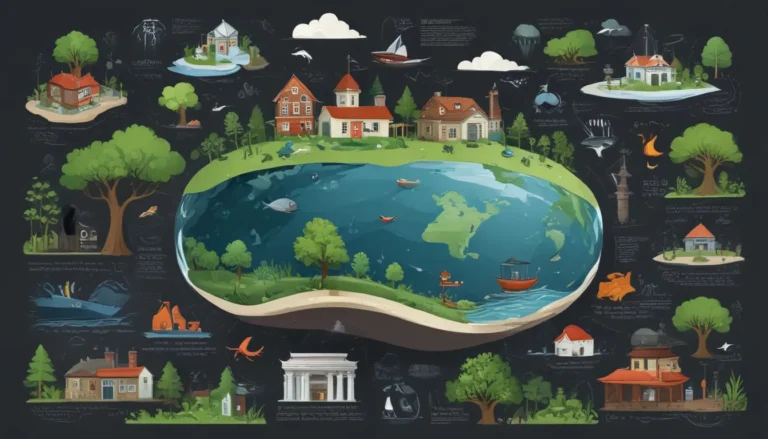A Note About Images: The images used in our articles are for illustration purposes only and may not exactly match the content. They are meant to engage readers, but the text should be relied upon for accurate information.
Urban heat islands are not just a quirk of modern city life; they are a pressing concern with far-reaching consequences. As cities expand and evolve, they create their own distinctive microclimates that are notably warmer than the surrounding countryside. This phenomenon, known as the urban heat island effect, is driven by factors such as the abundance of concrete and asphalt, the lack of greenery, and the concentration of human activities.
In this article, we will take a deep dive into the realm of urban heat islands and reveal nine astonishing facts about them. From their impact on human health to their implications for energy usage, these facts illuminate the urgent need for sustainable urban planning and effective mitigation strategies. Let’s peel back the layers of the seemingly innocuous urban landscapes we encounter daily and grasp the importance of addressing the urban heat island effect for the well-being of our cities and their residents.
The Nighttime Charm of Urban Heat Islands
Perhaps the most surprising revelation about urban heat islands is that they exert their greatest influence during the night. The retention of heat by buildings and surfaces like concrete throughout the day leads to a gradual release of warmth at night, resulting in higher nighttime temperatures in urban areas.
Embracing Greenery: Nature’s Cooling Solution
Did you know that strategically placed parks and green spaces can serve as allies in the fight against the urban heat island effect? Vegetation offers shade and aids in cooling the air through evapotranspiration, ultimately lowering the overall temperature of the locality.
Dance of the Elements: Urban Heat Islands and Weather Patterns
Urban heat islands can wield influence over local weather patterns, triggering changes in wind circulation and precipitation. These alterations can manifest as localized thunderstorms and increased cloud coverage over urban regions, shaping the climate of the area.
Green Roofs: A Breath of Fresh Air for Urban Heat Islands
The installation of green roofs on buildings presents an effective strategy to combat the urban heat island effect. These roofs, adorned with vegetation, contribute to insulation and cooling of the structure, thus diminishing the heat radiated into the environment.
Breeding Grounds for Pollution: Urban Heat Islands and Air Quality
Urban heat islands not only elevate temperatures but also exacerbate air pollution. The heightened warmth amplifies chemical reactions that produce pollutants like ozone, resulting in diminished air quality within urban settings.
The Aesthetic Impact: Building Design and Urban Heat Islands
The design and color palette of buildings wield a considerable influence on the severity of the urban heat island effect. Dark-hued materials absorb more heat, while lighter tones and reflective surfaces aid in heat reduction, mitigating the effects of the phenomenon.
The Heat is On: Human Health in Urban Heat Islands
Prolonged exposure to elevated temperatures in urban heat islands can take a toll on human health. Heat-related illnesses such as heat stroke and dehydration are more prevalent in urban locales with higher temperatures.
Dollars and Sense: The Economic Impacts of Urban Heat Islands
The urban heat island effect carries significant economic ramifications. Increased energy demand for cooling buildings, diminished agricultural productivity, and heightened healthcare costs due to heat-related illnesses collectively contribute to the financial burden associated with urban heat islands.
A Fiery Future: Climate Change and Urban Heat Islands
With the ongoing rise in global temperatures attributed to climate change, the urban heat island effect is poised to intensify. The synergy of escalating temperatures and urbanization can create even more scorching conditions in urban enclaves, necessitating the adoption of sustainable urban planning strategies.
In Closing
In conclusion, the urban heat island phenomenon is a stark reality in numerous urban areas worldwide. The soaring temperatures, particularly during sweltering summer months, can have profound impacts on the environment, human health, and quality of life. Understanding the causes and consequences of urban heat islands is pivotal for implementing effective mitigation measures to alleviate their adverse effects. By embracing sustainable urban planning and design practices, such as expanding green spaces, implementing cool roof technologies, and advocating for energy-efficient materials, cities can combat the urban heat island effect. Furthermore, public awareness and education play a pivotal role in fostering behaviors that mitigate the formation of urban heat islands. It is imperative for governments, policymakers, and urban planners to prioritize mitigation measures for urban heat islands, given that the issue is expected to escalate with ongoing urbanization and climate change. By proactively addressing this challenge, we can forge cooler, more resilient cities that prioritize the well-being of both inhabitants and the environment.
FAQs
Q: What causes the urban heat island effect?
A: The urban heat island effect arises from the replacement of natural vegetation with heat-absorbing materials like concrete and asphalt in urban locales. These materials retain heat during the day and emit it at night, resulting in heightened temperatures relative to rural surroundings.
Q: What are the impacts of the urban heat island effect?
A: The urban heat island effect can lead to increased energy usage for cooling buildings, heightened levels of air pollution, diminished air quality, heat-related illnesses, and even fatalities related to heat. It can also have adverse effects on wildlife and their habitats.
Q: Can the urban heat island effect be mitigated?
A: Yes, the urban heat island effect can be mitigated through diverse strategies. Common approaches include expanding green spaces, endorsing the use of cool roofing and paving materials, enhancing urban ventilation, and embracing sustainable urban planning practices.
Q: How can individuals contribute to mitigating the urban heat island effect?
A: Individuals can aid in mitigating the urban heat island effect by planting trees and vegetation, utilizing cool roof technologies on their residences, conserving water to reduce heat-related impacts, and advocating for sustainable transportation choices.
Q: Are all cities susceptible to the urban heat island effect?
A: Yes, to some degree, all cities face vulnerability to the urban heat island effect. However, the intensity of the effect can vary based on factors like geographical location, climate, urban density, and the implementation of urban planning strategies to counteract it.
Your exploration of urban heat islands has unveiled a rich tapestry of interconnected facts that underscore the pressing need for sustainable urban development. By fostering a deeper understanding of these phenomena and adopting proactive strategies, we can pave the way for cooler, greener cities that promote the well-being of both residents and the environment. Let’s embark on this journey towards a more harmonious urban landscape, where the heat of progress is balanced by the cool embrace of nature.






